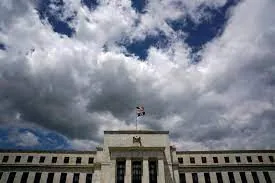Fed's Repo Facility: Banks' New Safety Net Amid Financial Uncertainties
Understanding the Fed's Repo Facility: Banks' New Safety Net Amid Financial Uncertainties

Banks Lean Into Fed's Safety Net: Navigating New Financial Terrain
Discover how banks are increasingly engaging with the Federal Reserve's Standing Repo Facility, fortifying financial stability and readiness for future uncertainties.
Introduction: Embracing Financial Prudence
In a significant shift within the banking sector, institutions are gradually warming up to the Federal Reserve's Standing Repo Facility, a critical backstop designed to bolster financial stability by providing emergency overnight cash. This development underscores a strategic evolution in how banks manage liquidity risks and ensure operational resilience.
Decoding the Fed's Standing Repo Facility
Established in July 2021, the Standing Repo Facility serves as a lifeline for banks, allowing them to secure emergency funds against Treasury and agency mortgage securities as collateral. Originally conceived to alleviate money market stresses, the facility aims to preempt liquidity crises by offering a reliable liquidity channel for banks, including those not classified as primary dealers but who are required to apply for access.
Historical Context: From Conception to Realization
The inception of the Repo Facility was a response to historical financial instabilities, highlighting the need for a robust mechanism to support the money markets. Despite initial reluctance from banks, due to concerns over potential stigma, the facility's relevance has grown, particularly in light of regulatory pressures and recent liquidity strains.
A Shift in Perception: Banks' Growing Acceptance
The change in banks' stance towards the Repo Facility reflects a broader recognition of its importance in maintaining financial stability. This acceptance has been facilitated by regulatory advocacy for preparedness against deposit outflows and concerns over future liquidity challenges as the Fed scales back pandemic-era stimulus measures.
Regulatory Push towards Enhanced Preparedness
In the wake of bank runs, regulators have emphasized the necessity for banks to fortify their liquidity management strategies. This includes leveraging the Repo Facility as a preemptive measure against potential liquidity shortages, showcasing a proactive approach to financial stability.
Anticipating Liquidity Needs Amidst Unwinding Stimulus
The unwinding of the Federal Reserve's expansive stimulus programs has sparked concerns over tightening liquidity conditions. Banks' engagement with the Repo Facility is a strategic response to these concerns, ensuring they remain well-positioned to navigate the evolving financial landscape.
Broadening Participation: A Closer Look at Banks' Involvement
The recent uptick in banks registering for the Repo Facility, particularly among regional institutions, signifies a growing acknowledgment of its strategic value. This trend is further exemplified by First Citizens Bank's decision to join as a counterparty, highlighting the facility's role in expanding banks' liquidity management tools.
Enhancing Financial Stability Through the Repo Backstop
The Repo Facility's role as a liquidity backstop is pivotal in ensuring banks can address funding scarcities promptly. Its significance is magnified when considering the challenges faced by banks like Silicon Valley Bank, underscoring the importance of preparedness in maintaining depositor and investor confidence.
Navigating Stigma and Transparency Challenges
Despite its benefits, the Repo Facility's effectiveness is tempered by concerns over stigma associated with accessing federal support. Efforts to destigmatize its use are crucial for encouraging wider adoption among banks, enhancing the overall resilience of the financial system.
The Federal Reserve's Commitment to Reducing Borrowing Stigma
The Fed's initiatives to repackage the discount window's perception through the Repo Facility reflect a strategic effort to normalize liquidity support mechanisms. By aligning the Repo Facility's operations with standard repo trades, the Fed aims to mitigate the stigma surrounding emergency borrowing.
Future Prospects: Expanding the Repo Facility's Role
As the financial sector continues to evolve, the Repo Facility's importance in ensuring stability and liquidity is expected to increase. Broader participation and continued efforts to address stigma will be key in maximizing its effectiveness as a financial stability tool.
Conclusion: A Strategic Pivot Towards Enhanced Resilience
The banking sector's growing engagement with the Federal Reserve's Standing Repo Facility marks a proactive shift towards ensuring financial stability and preparedness. By embracing this critical backstop, banks are not only safeguarding against liquidity risks but also reinforcing their commitment to operational resilience in the face of future uncertainties.
Summary:
This article delves into the evolving relationship between U.S. banks and the Federal Reserve's Standing Repo Facility. Initially met with hesitation, banks are increasingly registering for this emergency funding backstop, recognizing its potential to bolster stability in times of financial stress. Despite concerns over stigma and transparency, the move reflects a growing acknowledgment of the need for preparedness against liquidity crises.
For more insights into the evolving financial landscape and the role of strategic initiatives like the Fed's Standing Repo Facility in ensuring stability, visit Kiksee Magazine.
FAQs
- What is the purpose of the Fed's Standing Repo Facility?
- How does the Repo Facility support financial stability?
- Why were banks hesitant to use the Repo Facility initially?
- How have regulatory bodies influenced banks' adoption of the Repo Facility?
- What are the benefits for banks in becoming counterparties to the Repo Facility?
- How does the Repo Facility compare to the discount window in terms of usage and perception?
What's Your Reaction?






















